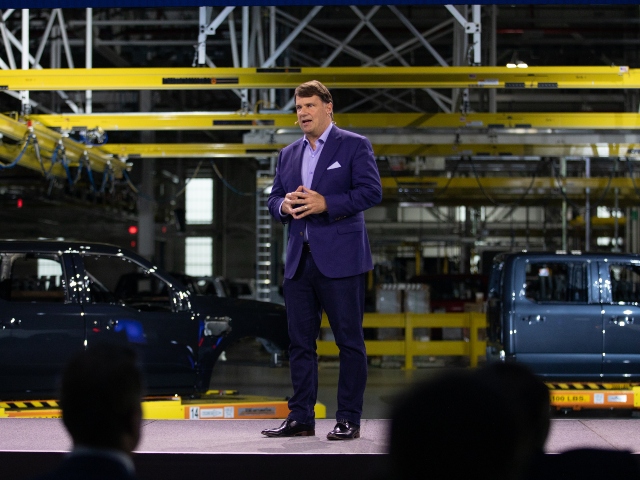The Ford F-150 Lightning, the electric iteration of America’s best-selling vehicle, was found to lose nearly a quarter of its range when carrying a load close to its maximum capacity according to tests performed by AAA.
The Verge reports that it was recently discovered that when carrying a load close to its maximum capacity, the Ford F-150 Lightning, the electric version of America’s best-selling vehicle, lost nearly a quarter of its range.

James Farley, president and chief executive officer of Ford Motor Co., speaks during a launch event for the 2022 Ford F-150 Lightning all-electric truck at the Rouge Electric Vehicle Center in Dearborn, Michigan, U.S., on Tuesday, April 26, 2022. Ford has 200,000 reservations for the F-150 Lightning and is expanding the Rouge Electric Vehicle Center to ramp up production to a planned annual run rate of 150,000 in 2023. Photographer: Emily Elconin/Bloomberg
The F-150 Lightning has been marketed with towing and hauling capabilities at its core. It has a 98kWh battery for the standard version and a 131kWh battery for the long-range version. However, some people have expressed concern over the practical effects of using an electric truck to transport large loads.
A series of tests were carried out by the American Automobile Association (AAA) to ascertain the effect of payload on the F-150 Lightning’s range. The findings showed that the vehicle’s range was significantly reduced when it was carrying 1,400 pounds of cargo — just 110 pounds short of the gross weight rating of the truck.
“Our testing revealed a significant range reduction, but it’s important to note that the Lightning was loaded to near its maximum capacity,” said Greg Brannon, director of AAA Automotive Engineering. “Most buyers will likely use their Lightning with a lighter load, resulting in a much smaller range reduction.”
The 300-mile range of the F-150 Lightning has been certified by the Environmental Protection Agency (EPA). The AAA’s tests, however, revealed a different picture. The range was discovered to be 278 miles without a payload, which is 7.3 percent less than what the EPA predicted. When 1,400 pounds were added, the range decreased to 210 miles, a 24.5 percent decrease from the unloaded state and a 30 percent decrease from the EPA estimate.
Real life testing by enthusiasts and YouTubers have painted a far bleaker picture for Ford’s electric truck. Breitbart News previously reported on a YouTuber’s test that proved to be a “complete and total disaster.”
“I had this thing charged to just over 200 miles when I started my day, so ample margin for error when it comes to range and towing and also considering the fact that the trailer was going up empty two times,” Hoover added.
After attaching the empty aluminum trailer to his truck and “pulling out my neighborhood,” which was just about a quarter of a mile away, the EV had already lost three miles of range. By the time Hoover got to his location 32 miles away, the vehicle had lost a staggering 68 miles of range.
Once he loaded up the Model A truck and drove it back to his neighborhood, Hoover “got the driving range low warning,” and saw that he only had 50 miles of range left, despite charging the EV for 200 miles at the start of his 64-mile round trip.
“Are you kidding me? That’s almost 90 miles of range in 30 miles. Are you serious? That’s nuts. What a joke,” Hoover reacted.
“So, yeah, that was abysmally bad, and if the future is electric, there has to be some kind of solution for this,” he said. “I have no idea why EVs tow so bad. My guess would be it doesn’t have a normal transmission where there’s gears and a car’s in a lower rev range.”
Read more at the Verge here.
Lucas Nolan is a reporter for Breitbart News covering issues of free speech and online censorship. Follow him on Twitter @LucasNolan
usechatgpt init success


